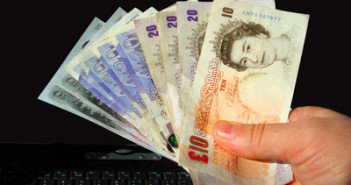Despite the increase in retail activity that traditionally accompanies the Christmas season, retail data released this morning was disappointing and gives further indication that the UK economy will contract in the final quarter of 2012. Yet the pound remains strong against the UK’s major trading partners.
Brits are really feeling the pinch this holiday season. The cost of living is increasing across the board, leaving many consumers with less disposable income this Christmas. While the inflation figures earlier this week were good news for the pound, they come at the expense of the high street, which is suffering from weak consumer demand and lower-than-expected retail figures. Consumers continue to face the squeeze of inflation rising more sharply than take home pay.
Guest post by Phil McHugh, senior analyst at Currencies Direct.
It is not only British consumers feeling the pinch. Since January of this year, the gains in the pound have been a major drag on Britain’s export market, further hampering growth. Sterling is over 5 per cent higher against the USD – testing yearly highs – and is also 2 per cent up on the euro since January 2012. The move higher is primarily down to a post-Olympic increase in Q3 GDP and higher inflation figures.
The pound has navigated a trend of aggressive central bank action by the US Fed and the Bank Of Japan, which has weakened the USD and JPY respectively and aided the pound. Nevertheless, it looks increasingly likely that the sterling bull run could be coming to an end.
The UK economy is stuck in a rut and it’s unlikely to see much growth in the New Year. Government austerity measures, coupled with the Bank of England’s reduced scope for further quantitative easing make it seem quite likely that the beginning of 2013 could bring some pain for the pound. We’re likely to hear the rumblings ramping up from the credit rating agencies, and the UK’s AAA rating could be at risk.
Adding to the potential misery for the pound is the positive outlook for the US economy which is expected to outperform a stagnating UK economy. Meanwhile the euro is reviving currently trading at its highest level – 1.3250 – against the dollar since April 2012 after clearing some of its tail risks.
Ironically, the potential repercussion from a flagging pound should be positive news for Britain’s export market. With the Queen’s Diamond Jubilee and the Olympics enthusiasm, 2012 was a banner year for Britain. However, all signs point to 2013 being a year for the legendary British stiff upper lip.
Later this week we get feedback on the final revision of third quarter UK GDP which is expected to hold firm at 1 per cent and could be the last hoorah for the UK economy. What will be more telling is the feedback on consumer confidence which is expected to fall further and could set the tone for 2013.
Phil McHugh has over ten years’ experience in the foreign exchange markets. He heads up the Corporate FX desk handling a portfolio of businesses which have an FX requirement of $2.5bn a year. He provides counsel on a diverse range of topics, from analysis of Bank of England interest rates policy and currency movements, to the impact of foreign exchange on international trade, travel and property markets.
